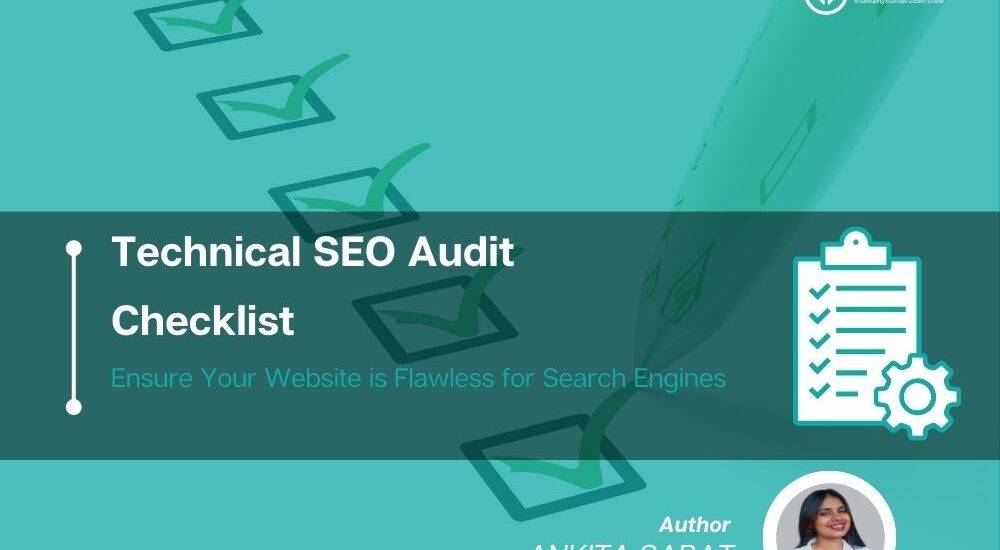Technical SEO Audit Checklist
Ensure Your Website is Flawless for Search Engines

A technical SEO audit is a critical aspect of website optimization that should not be overlooked. But, to maintain the stability of your site for technical SEO, you need to communicate with an SEO company. If you ignore technical audits then this can lead to poor website performance, compromised user experience, and loss. Also, if you neglect other technical difficulties or flaws then this might jeopardize the previous SEO efforts on your site.
Don’t stress on this! Here, we are to guide you to the essentials of a technical SEO audit. We will cover theoretical and practical aspects of technical SEO.
By following these steps, you may fine-tune your site to improve both search engine rankings and user experience.
Do you know about Technical SEO? - Let’s learn more about it
A technical SEO audit helps you to completely evaluate your website’s technical health and performance. As a result, this examination includes various types of site tests, such as crawlability, indexing, site structure, website loading speed, and overall performance, among others.
With the help of this you can easily identify and fix technical problems. During this complete examination, you can make sure that your online presence continues to function properly. Once you repair the website issues, then you will see it in search engine results. Due to this, the users feel happy and satisfied. Technical audits provide you with a variety of purposes, depending on the situation of your online site.
Remember: Frequent situations involve getting ready a portal for the time of release, improving continuing procedures, managing site migrations, and responding to Google penalties.
This technical audit list is intended to be applicable to the world. This checklist includes all essential steps of a technical SEO audit. However, you can adjust the technique to meet your specific goals and objectives. And accordingly you can customize the technical SEO audit process.
Steps to maintain an accurate technical SEO audit
Get access to professional SEO tools
Content is still very important in determining a website’s search engine ranks even though it’s not a “technical” SEO ranking criteria. As a result, it is very important to verify that your content is visible to search engines, which makes it an excellent beginning point for your technical SEO site assessment.
Confirm it a point that your material is visible to Googlebot as well as to people who visit by carefully going over your website’s home page, category pages, and product pages. Since different content management systems handle these pages differently. Hence, your checklist should cover each type of content in it.
Usually if the website loads normally, you don’t need to be worried, especially if the information looks properly in Google. Googlebot renders pages using a modified version of the Chrome browser engine.
Generally, if your site renders normally, you shouldn’t have any concerns – particularly if your content appears correctly in Chrome. Googlebot utilizes a version of the Chrome browser engine to render pages.
To find out if any important components of your page—like content, links, or menu bar items—are missing, you can turn off JavaScript in Chrome. Links and navigational components may suggest that Googlebot is unable to access them, but this is not always the case.
Make Sure Your Content is Visible
If your website currently has Google Analytics tracking, it is a good idea to make sure everything is configured correctly and operating as intended. You may get the steps you need to achieve this by using our On-Page SEO website analysis guide.
Look for the tracking code linked to your Google Analytics account and property in the source code (by using Control + U) of your homepage, primary category pages, and product pages. To guarantee consistent tracking implementation, it is advisable to inspect each type of page as different Content Management Systems (CMSs) handle page templates in different ways.
The tracking code usually has an Identifier that you can compare with your Google Analytics property or view, and it should be inserted inside the main html (between <head> and </head>).
Verifying Canonicalization
Look at your website’s source code to see if the rel=”canonical” href=”www.example.com/page” is there. One simple way to confirm canonicalization is to run a page search for “canonical” in the source code.
Make sure the mentioned URL is up to date and reachable.
After that, expand your website’s verification procedure to include product and category pages, and keep track of the results.
It’s possible that the canonical tag isn’t always displayed due to differences in HTML formatting. Google’s Lighthouse browser plugin can be used in these situations to confirm canonicalization. After installing the plugin, choose “Options”, make sure the “SEO” checkbox is checked, and then click “Generate Report”. After the report is prepared, make sure it says the following in the SEO > Not Applicable > Content Best Practices section: “Document has a valid rel=canonical”
Accessing Google Search Console
Anyone with a website may use Google’s Search Console for free. It’s an essential tool for assessing the SEO health of your brand’s website. Make sure that you can access Search Console successfully should be part of your technical SEO audit checklist.
In addition to this, if you want to check whether your site is error free then you can log into the correct Gmail account of your website by visiting Google Search Console. Also, you may discover your existing Search Console account here, or create a new one.
Locate the adjacent property for your website using Search Console. Make sure your site’s domain and protocol match the ongoing/updated version of the website by checking them in Search Console.
Very Important to know about is: https://example.com and https://www.example.com are not the same thing.
A crucial phase in your overall SEO is to confirm that your site is good enough to load your contents. Also, the website should be able to handle the users traffic.
Wrapping it up at the end - Technical SEO Audit, is a gateway to your brand’s success!
To the end, you need to look out for a complete website check before launching it. However, you have to take care of recent flaws in your website to avoid technical glitch. After completing your technical SEO audit checklist, you can move ahead on the journey of increasing your site’s SEO health and performance.
It is not that easy to improve your SEO performance. As a result, sometimes it can be a complex and time-consuming task. However, following the rules and checklist above can help you to stabilize organic performance over the long term.






